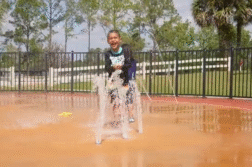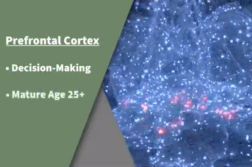COLUMBUS, Ohio (Ivanhoe Newswire)— Spinal muscular atrophy, or SMA is a disease that attacks and kills nerve cells in the brain and spinal cord. In the most severe cases, people lose their ability to walk, speak, swallow, and breathe on their own. Babies with the most severe form have not survived past age two. Now, new treatments, including an FDA approved oral medication are giving young patients a second chance.
Five-year-old Donovan Weisgarber can’t get enough of the playground.
His dad, Matt, soaks in every minute. At six weeks old, doctors diagnosed Donovan with type one spinal muscular atrophy. They told the family that their newborn son would quickly waste away.
“But as far as stopping the progress of the disease, there was nothing available. So, we were told, go home and love him for as long as you have him,” shared Matt.
But shortly after his diagnosis, doctors learned about an experimental gene therapy for SMA. Donovan became the fifteenth person in the world to have his missing gene replaced with a synthetic one. Then, last year, Donovan began taking a new oral medication for SMA called Evrysdi . Evrysdi is taken by the mouth, or directly into a patient’s feeding tube. The drug works by increasing a protein that SMA patients are missing.
“This really is a game changer for our field,” said Perry Shieh, MD, PhD, Professor of Neurology and Pediatrics, David Geffen School of Medicine at UCLA.
“In my book, it’s as close to a cure as you can get. And we scientists actually hate using that word cure, but I would say that we’re pretty close,” stated Karen Chen, PhD, CEO, Spinal Muscular Atrophy Foundation.
Matt repeatedly hoists his 48-pound son up in the air—using playtime to ensure Donovan maintains muscular strength while Evrysdi works from within.
“Since he started taking it, we noticed he’s able to stand longer. SMA should not be the thing that does him in,” said Matt.
The FDA approved Evrysdi last August after several clinical trials. In one trial, after 23 months or more of treatment, 81 percent of SMA patients were alive without permanent ventilation. Researchers say that is a noticeable improvement from the typical progression of the disease.
Contributors to this news report include: Cyndy McGrath, Executive Producer; Kirk Manson, Videographer; Roque Correa, Editor.
To receive a free weekly e-mail on medical breakthroughs from Ivanhoe, sign up at: http://www.ivanhoe.com/ftk
Sources:
https://www.ninds.nih.gov/Disorders/Patient-Caregiver-Education/Fact-Sheets/Spinal-Muscular-Atrophy-Fact-Sheet#:~:text=Spinal%20muscular%20atrophy%20(SMA)%20is,to%20muscle%20weakness%20and%20atrophy, https://www.evrysdi.com/
MEDICAL BREAKTHROUGHS
RESEARCH SUMMARY
TOPIC: NEW DRUG FOR SMA: CLOSE TO A CURE!
REPORT: MB #4920
BACKGROUND: Spinal muscular atrophy (SMA) is a genetic disease affecting the central and peripheral nervous systems, and voluntary muscle movement. Most of the nerve cells that control muscles are in the spinal cord. SMA is muscular because its primary effect is on muscles, which don’t receive signals from these nerve cells. The medical term for getting smaller, atrophy, is what happens to muscles when they’re not stimulated by nerve cells. SMA involves the loss of nerve cells called motor neurons in the spinal cord and is classified as a motor neuron disease. The earlier the age of onset, the greater the impact on motor function. Children who display symptoms at birth or in infancy typically have the lowest level of functioning. Later-onset with a less severe course generally correlates with increasingly higher levels of motor function.
(Source: https://www.mda.org/disease/spinal-muscular-atrophy)
CAUSES AND SYMPTOMS: People diagnosed with SMA are either missing part of the SMN1 gene or have a mutated gene. A healthy gene produces SMN protein which motor neurons need to survive and function properly. People with SMA don’t make enough of this protein, so the motor neurons shrink and die, resulting in the brain not being able to control voluntary movements. SMA symptoms vary, but in general people will experience a progressive loss of muscle control, movement, and strength. The muscle loss gets worse with age. The disease tends to severely affect the muscles closest to the torso and neck. Some people with SMA never walk, sit, or stand, while others gradually lose their ability to do these actions.
(Source: https://my.clevelandclinic.org/health/diseases/14505-spinal-muscular-atrophy-sma)
NEW ORAL TREATMENT FOR SMA: FDA approved, Evrysdi, contains a survival of motor neuron 2-directed RNA splicing modifier. The effectiveness of Evrysdi for the treatment of patients with infantile-onset and later-onset SMA was evaluated in two clinical studies. The first study included 21 patients with an average age of 6.7 months. Effectiveness was established based on the ability to sit without support for at least five seconds and survival without permanent ventilation. After 12 months of treatment, 41% of patients were able to sit independently for more than five seconds, and after 23 or more months, 81% of patients were alive without permanent ventilation. Patients with later-onset SMA were evaluated in a second study that included 180 patients aged two to 25 years. The primary endpoint was the change from baseline in MFM32 (a test of motor function) total score at the one-year mark. Patients on Evrysdi saw an average 1.36 increase in their score at the one-year mark, compared to a 0.19 decrease in patients on placebo.
FOR MORE INFORMATION ON THIS REPORT, PLEASE CONTACT:
1-833-EVRYSDI (387-9734)
If this story or any other Ivanhoe story has impacted your life or prompted you or someone you know to seek or change treatments, please let us know by contacting Marjorie Bekaert Thomas at mthomas@ivanhoe.com




